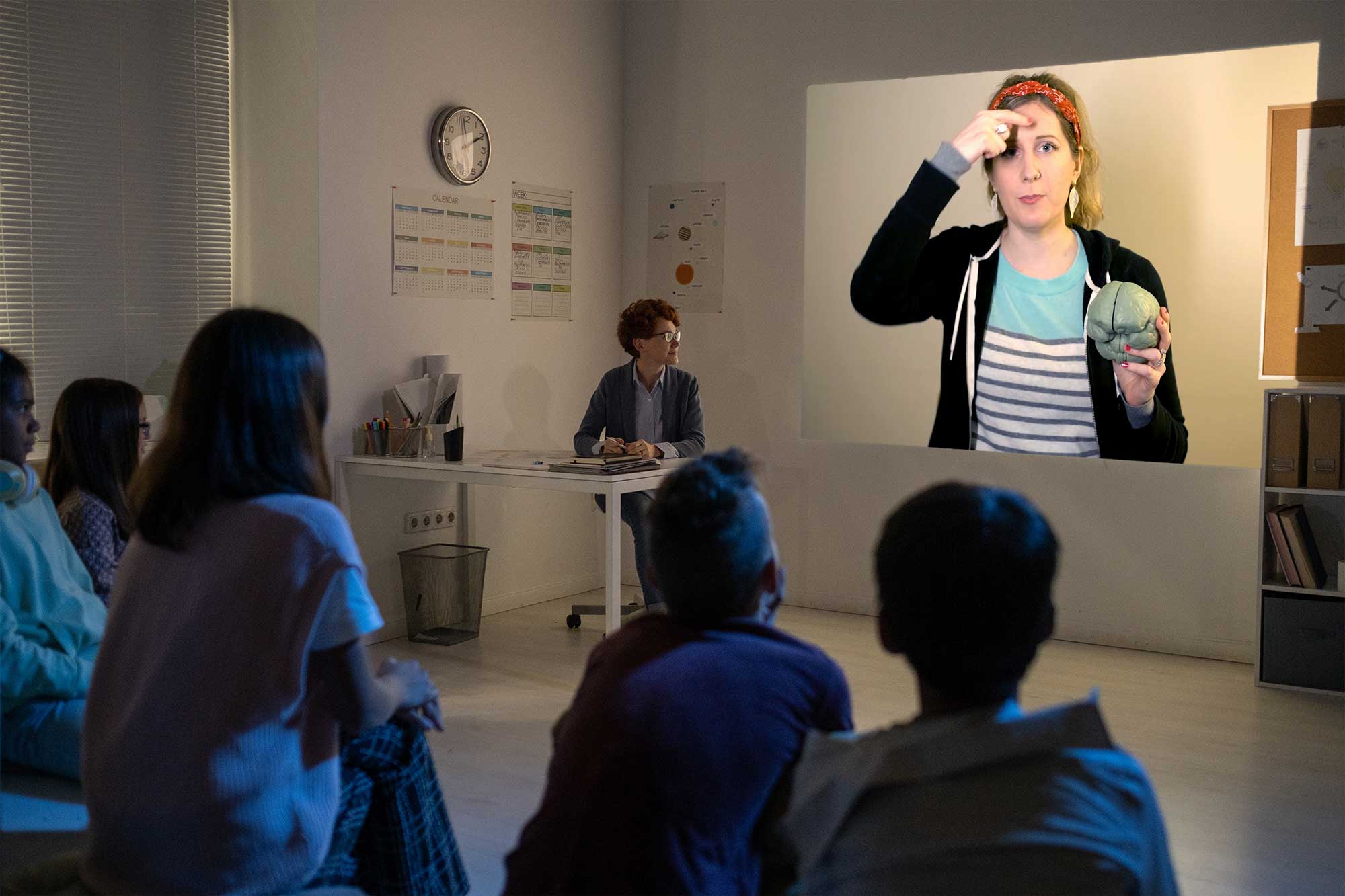No one self-regulation tactic is right for every child or every situation.
That’s why all Roots Up videos include a repertoire of research-backed self-soothing strategies.

Our stress-relief videos are loved by children and caregivers alike at over 25 organizations.
All facilitators have to do is press play
Teachers, social workers, and program facilitators don’t need to be familiar with yoga, mindfulness, deep breathing, or guided imagery to use our videos successfully.
Roots Up facilitators just press play. And they often participate alongside the children they serve, so they can take 5 minutes to self-soothe, too.
Read our case studies below to see their results.
Real Stories from Educators
Portland, Maine
Improving children’s readiness to learn and behaviors, and reducing teacher overwhelm at Riverton Elementary
Context
- Method: Roots Up Video Library 3-5 times per week, assessed teacher reports of children’s readiness to learn, using a continuous assessment, repeated-measures design.
- Number of students: Approximately 400
- Ages: 5-10
- Validated tool: Behavioral and Emotional Rating Scale, Second Edition (BERS-2)
Outcomes
Overall, aggregated data were compiled from all days when the video Library was used, compared with days the video Library was not used, resulting in:
- A sweeping pattern of more positive teacher evaluations of the students’ behavior and more overall readiness to learn during wellness video days.
- Teachers’ reporting of self-efficacy and emotional well-being improved on wellness video days.


Portland, Maine
Chris Salamone, Licensed Clinical Social Worker, explains how his school used Roots Up as part of a self-soothing program for children who survived traumatic events:
“When I first met Julie, I had just started in a school that had 130-150 newcomers who had just arrived, escaping a civil war.
They came across the ocean, had to travel up through the rainforest jungles in Brazil, up through South America, and then got to the American border, and ended up in Portland, Maine.
And then they ended up in our school.
Many of these kids had been through and seen things that no one should have to see, never mind a kid who’s 5, 6, 7, or 8 years old.
So when they came to school after that kind of experience, they were expected to sit quietly with their feet flat on the ground, listen to a teacher talk, take in that information, make sense of it, process it, and meet the demands of American school — which is really based a lot in conformity, when conformity was not what they needed to do in order to survive.
So, they were not really ready to be in school.
We had a lot of kids who couldn’t sit still. Their bodies were moving about physically, just impacted by the amount of stress that they had been under for a long period of time.
We wanted to put a program in place that could help those kids in particular, but alongside all the kids in the school as well, learn to get calmer, have a more positive outlook, and let some of their fears go of things that had happened in the past.
And so Julie came in and did a training for the staff, provided videos, and she did work directly with a lot of the students, as well…
And each of the teachers then, at least once a day, were putting one of her videos in and practicing with the kids how to relax your body, get focused, get in a more positive frame of mind, and let some of your fears go.
And when we started doing that, we noticed a dramatic difference in the climate of the school.
And of course, it wasn’t just Julie’s videos — there were other things that were going on as well. But, we do climate surveys in our schools to check in with kids about how they’re feeling about school and how positive they are. And when we started using her videos, the climate surveys were much more positive.
Julie did some research, too, with the University of Maine… We were able to show that our number of office referrals was down, and the number of kids who were more successful in classrooms was up.
There were a number of areas where we saw change in their ability to access school and be more comfortable in their own bodies and skin…
Overall, the kids seemed to be calmer, they seemed to be nicer to each other, and the teachers did notice that the kids were in a better place to learn.”


Eaglewood, Colorado
Children at Greenwood Elementary improved emotional awareness of themselves and others
Context
- Method: Roots Up Video Curriculum 3-5 times per week for 8 weeks
- Number of students: Approximately 75
- Ages: 9 & 10
- Validated tool: Behavioral and Emotional Rating Scale
Outcomes
Our findings showed that students had a statistically significant improvement in:
- Interpersonal strength: Ability to control emotions and behaviors in a social situation.
- Involvement with family: Participation and relationship with their family.
- Intrapersonal strength: Outlook on their competence and accomplishment.
- Affective strength: Ability to express feelings towards others and to accept affection from others.
Portland, Maine
Decreasing stress and increasing concentration for children at Parkside Headstart.
Context
- Method: Roots Up Video Curriculum 3 times per week for 4 weeks**
- Number of students: 18
- Ages: 4 & 5
- Validated tool: The Strengths & Difficulties Questionnaire
Outcomes
- Students showed a decrease in overall stress, emotional distress, behavioral difficulties, hyperactivity and concentration difficulties and difficulties getting along with other children.
- 94% of students’ stress scores decreased post program.

Denver, Colorado
Improving overall quality of life for 28-year-old graduate students at Denver University.
Context
- Method:Roots Up Video Curriculum in conjunction with 45-minute group wellness activities and independent use of a web-based wellness platform.
- Ages: 28-year-old graduate students
- Validated tool: Burckhardt, C. S., & Anderson, K. L. (2003). The Quality of Life Scale (QOLS): Reliability, Validity, and Utilization. Health and Quality of Life Outcomes, 1, 60
Outcomes
- Increased average Quality of Life scores for adults average 28 years old.
Featured In





































